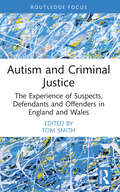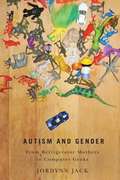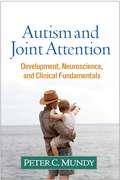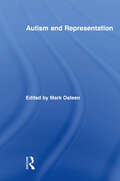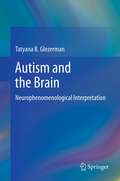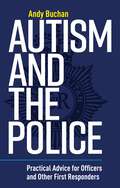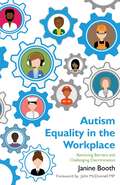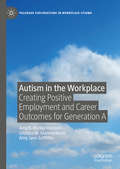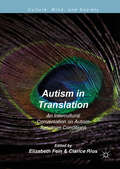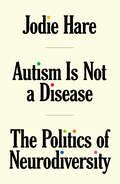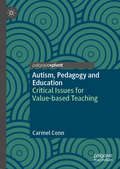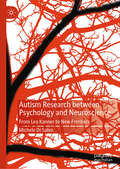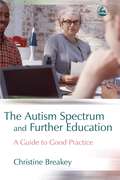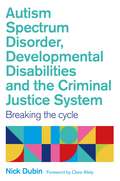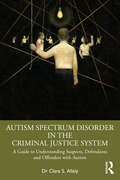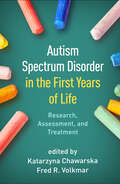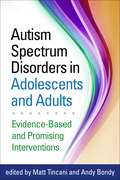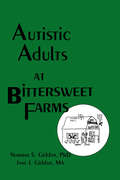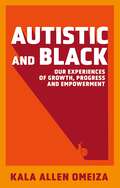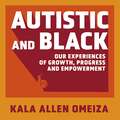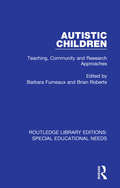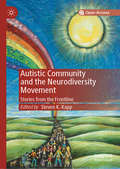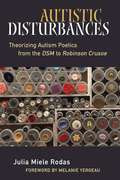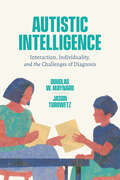- Table View
- List View
Autism and Criminal Justice: The Experience of Suspects, Defendants and Offenders in England and Wales (Routledge Contemporary Issues in Criminal Justice and Procedure)
by Tom SmithThis collection presents a summary of current knowledge regarding autistic suspects, defendants and offenders in the criminal justice system of England and Wales. The volume examines the interaction between each stage of the criminal justice process and autistic individuals accused or convicted of crime, considering the problems, strengths, and possibilities for improving the system to better accommodate the needs of this vulnerable category of neurodiverse individuals. By explicating the core issues in this important but disparate area of study in a single place, the collection facilitates understanding of and engagement with knowledge for a wider audience of relevant stakeholders, including criminal justice practitioners, policy makers, academics and clinicians. It also incorporates key recommendations for improvement, thereby clarifying the urgent need for substantive change in policies and practices. The ultimate goal is to both improve the treatment and experience of autistic people subjected to criminal justice processes; and produce fairer, more appropriate systemic outcomes. While focused on the criminal justice system of England and Wales, the work will be valuable for researchers and policy-makers working in similar systems, as well as those interested in neurodiversity more generally.
Autism and Gender: From Refrigerator Mothers to Computer Geeks
by Jordynn JackThe reasons behind the increase in autism diagnoses have become hotly contested in the media as well as within the medical, scholarly, and autistic communities. Jordynn Jack suggests the proliferating number of discussions point to autism as a rhetorical phenomenon that engenders attempts to persuade through arguments, appeals to emotions, and representational strategies. In Autism and Gender: From Refrigerator Mothers to Computer Geeks, Jack focuses on the ways gender influences popular discussion and understanding of autism's causes and effects. She identifies gendered theories like the “refrigerator mother” theory, for example, which blames emotionally distant mothers for autism, and the “extreme male brain” theory, which links autism to the modes of systematic thinking found in male computer geeks. Jack's analysis reveals how people employ such highly gendered theories to craft rhetorical narratives around stock characters--fix-it dads, heroic mother warriors rescuing children from autism--that advocate for ends beyond the story itself while also allowing the storyteller to gain authority, understand the disorder, and take part in debates. Autism and Gender reveals the ways we build narratives around controversial topics while offering new insights into the ways rhetorical inquiry can and does contribute to conversations about gender and disability.
Autism and Joint Attention
by Peter C. MundyFrom a preeminent researcher, this book looks at the key role of joint attention in both typical and atypical development. Peter C. Mundy shows that no other symptom dimension is more strongly linked to early identification and treatment of autism spectrum disorder (ASD). He synthesizes a wealth of knowledge on how joint attention develops, its neurocognitive underpinnings, and how it helps to explain the learning, language, and social-cognitive features of ASD across the lifespan. Clinical implications are explored, including reviews of cutting-edge diagnostic methods and targeted treatment approaches.
Autism and Representation (Routledge Research in Cultural and Media Studies)
by Mark OsteenAutism, a neuro-developmental disability, has received wide but often sensationalistic treatment in the popular media. A great deal of clinical and medical research has been devoted to autism, but the traditional humanities disciplines and the new field of Disability Studies have yet to explore it. This volume, the first scholarly book on autism in the humanities, brings scholars from several disciplines together with adults on the autism spectrum to investigate the diverse ways that autism has been represented in novels, poems, autobiographies, films, and clinical discourses, and to explore the connections and demarcations between autistic and "neurotypical" creativity. Using an empathetic scholarship that unites professional rigor with experiential knowledge derived from the contributors’ lives with or as autistic people, the essays address such questions as: In what novel forms does autistic creativity appear, and what unusual strengths does it possess? How do autistic representations--whether by or about autistic people--revise conventional ideas of cognition, creativity, language, (dis)ability and sociability? This timely and important collection breaks new ground in literary and film criticism, aesthetics, psychology, and Disability Studies.
Autism and the Brain: Neurophenomenological Interpretation
by Tatyana B GlezermanFor years, the typical presentation of autism--the developmental delays, the social and linguistic deficits--has been well known. Despite great variation among children with this condition, certain symptoms are considered hallmarks of the disorder. Less understood is why these symptoms come together to construct autism. And as autism rates continue to rise, this information is ever more vital to accurate diagnosis and treatment. Autism and the Brain offers answers by showing a new neuropsychology of the autistic spectrum, reviewing general brain organization, and relating specific regions and structures to specific clinical symptoms. The author identifies deficiencies in areas of the left-hemisphere associated with the self and identity as central to autism. From this primary damage, the brain further reorganizes to compensate, explaining the diverse behaviors among low- and high-functioning individuals as well as autistic savants. The result is a unique three-dimensional view of brain structure, function, and pathology, with in-depth focus on how the autistic brain: Perceives the world. Understands and uses words. Perceives faces. Understands spatial relations and numbers. Understands feelings and registers emotions. Perceives the self as separate from others. Acts in the world. Challenging readers to re-think their assumptions, Autism and the Brain is breakthrough reading for researchers, clinicians, and graduate students in fields as varied as child and adolescent psychiatry; clinical child, school, and developmental psychology; neuroscience/neurobiology; special education and educational psychology; social work; communication disorders; and public health and policy.
Autism and the Police: Practical Advice for Officers and Other First Responders
by Andrew BuchanThis is a practical guide for police officers and other first responders written by an autistic retired policeman, designed to demystify autistic behaviours and improve the treatment of autistic people caught up in the criminal justice system. Police officers and other emergency services are the first to arrive at the scene of an incident and it is vital they can recognise autistic behaviours and respond accordingly to avoid any escalation. This book lays out how to identify whether someone could be autistic and how officers can interact with them effectively and sensitively. Based on the author's many years of experience as a police officer it covers common scenarios such as stop and search, restraint and transportation, interviews and detention. For each potential encounter the book provides strategies, examples and tips to assist police in interacting safely and fairly with autistic people. In addition to police interactions, the book explains how to best respond to and assist autistic people through the Criminal Justice System and beyond.
Autism Equality in the Workplace: Removing Barriers and Challenging Discrimination
by John Mcdonnell Janine BoothNeurodiversity in the workplace can be a gift. Yet only 15% of adults with an autism spectrum condition (ASC) are in full-time employment. This book examines how the working environment can embrace autistic people in a positive way. The author highlights common challenges in the workplace for people with ASC, such as discrimination and lack of communication or the right kind of support from managers and colleagues, and provides strategies for changing them. Setting out practical, reasonable adjustments such as a quiet room or avoiding disruption to work schedules, this book demonstrates how day to day changes in the workplace can make it more inclusive and productive for all employees. Autism in the Workplace is intended for any person with an interest in changing working culture to ensure equality for autistic people. It is an essential resource for employers, managers, trade unionists, people with ASCs and their workmates and supporters.
Autism Friendly Cities: How to Develop an Inclusive Community
by Jennifer PercivalAccess. Inclusion. Diversity. All people deserve to be embraced by their community. Autism Friendly Cities: How to Create an Inclusive Community is the first book designed to guide city leadership and staff through the process of evaluation, training, implementation, and developing an Autism Friendly initiative that will help you open your doors to everyone. People with autism should be able to participate in all that is offered and facilitated by their city, including services, activities, events, and points of connection. Being an Autism Friendly City is not only socially responsible, but will improve engagement, outreach, economic development, and resident satisfaction.
Autism in the Workplace: Creating Positive Employment and Career Outcomes for Generation A (Palgrave Explorations in Workplace Stigma)
by Amy E. Hurley-Hanson Cristina M. Giannantonio Amy Jane GriffithsThis book explores the career experiences of Generation A, the half-million individuals with autism spectrum disorder (ASD) who will reach adulthood in the next decade. With Generation A eligible to enter the workforce in unprecedented numbers, research is needed to help individuals, organizations, and educational institutions to work together to create successful work experiences and career outcomes for individuals with ASD. Issues surrounding ASD in the workplace are discussed from individual, organizational, and societal perspectives. This book also examines the stigma of autism and how it may affect the employment and career experiences of individuals with ASD. This timely book provides researchers, practitioners, and employers with empirical data that examines the work and career experiences of individuals with ASD. It offers a framework for organizations committed to hiring individuals with ASD and enhancing their work experiences and career outcomes now and in the future.
Autism in Translation: An Intercultural Conversation on Autism Spectrum Conditions (Culture, Mind, and Society)
by Elizabeth Fein Clarice RiosAutism is a complex phenomenon that is both individual and social. Showing both robust similarities and intriguing differences across cultural contexts, the autism spectrum raises innumerable questions about self, subjectivity, and society in a globalized world. Yet it is often misrepresented as a problem of broken bodies and disordered brains. So, in 2015, a group of interdisciplinary scholars gathered in Rio de Janeiro, Brazil for an intellectual experiment: a workshop that joined approaches from psychological anthropology to the South American tradition of Collective Health in order to consider autism within social, historical, and political settings. This book is the product of the ongoing conversation emerging from this event. It contains a series of comparative histories of autism policy in Italy, Brazil, and the United States; focuses on issues of voice, narrative, and representation in autism; and examines how the concept of autism shapes both individual lives and broader social and economic systems. Featuring contributions from:Michael BakanBenilton BezerraPamela BlockM. Ariel Cascio Jurandir Freire CostaBárbara Costa AndradaCassandra EvansElizabeth Fein Clara Feldman Roy Richard GrinkerRossano LimaFrancisco OrtegaDawn Prince-HughesClarice Rios Laura Sterponi Thomas S. WeisnerEnrico Valtellina
Autism is not a Disease: The Politics of Neurodiversity
by Jodie HareHow to build a fairer, more neuro-inclusive societyNeurodiversity is one of the most urgent political issues of our time. As the number of diagnoses of autism, ADHD, and other types of neurodivergence rises, we are starting to understand that there is no such thing as a 'normal' brain. But society is still organised around neuronormativity, and autism is treated as a disease.Jodie Hare, diagnosed with autism at twenty-three, argues it is time to redefine the politics of who we are. She calls for the recognition of diversity as part of natural variation, rather than a departure from sameness. This will have an impact on the places where we learn, work, and socialise - and Hare shows how these can be adapted to be more inclusive and accessible. She shows how we might commit to building a world where we can all thrive, one that works to combat discrimination based on race, class, gender, and disability.
Autism, Pedagogy and Education: Critical Issues for Value-based Teaching
by Carmel ConnThis book discusses critical issues concerning autism and education, and what constitutes effective pedagogy for this group of learners. Autism is a high-profile area within the discipline of special education, and the issue of how to teach autistic learners remains a contested one: recent theorising has questioned a techno-rationalist approach that places the burden of change on the autistic pupil. The author explores the values that underpin educational approaches within existing pedagogical practice: while these approaches have their individual merits and shortcomings, this book introduces and expands upon a strengths-based approach. This book will appeal to students and scholars of autism and education, with particular regard to teaching autistic learners.
Autism Research between Psychology and Neuroscience: From Leo Kanner to New Frontiers
by Michele Di SalvoThis book offers an overview of the history, definitions, and treatments for autism spectrum disorders from 1943 to the present day. Bridging the gap between psychology and neuroscience through a rigorous reconstruction of eighty years of research, the author retraces the emergence of the definition of autism and the description of its characteristics, the history of the diagnosis and standardized classification of ASD in the Diagnostic and Statistical Manual of Mental Disorders, and the development of etiological research and therapeutic interventions in medical, psychoeducational, and alternative therapies. The content spans neurology, genetics, psychiatry, and medicine, integrating discoveries from different fields to shed light on relevant factors of the pathology and dynamics of ASD. A useful resource for students and researchers in psychology, psychiatry, special education, and healthcare, this book unveils the latest advances in the field of ASD and discusses the research agenda for the years to come, showcasing multidirectional approaches to improve the quality of life of autistic people.
The Autism Spectrum and Further Education: A Guide to Good Practice
by Christine BreakeyThis guide for professionals working with students with autism spectrum conditions (ASCs) in further education meets the increasing demand for information and support on this subject. Christine Breakey provides useful guidelines and practical advice on teaching young adults successfully and confidently, emphasising the development of resources and practical skills for use specifically in FE colleges. The author covers all the key areas and offers strategies and solutions for communicating effectively, helping students to manage transition, and understanding and minimising the causes of ASC behaviours as well as teaching social skills and ASC self-awareness. The Autism Spectrum and Further Education will be a vital resource for professionals in FE institutions who have to meet the needs of young adults with ASCs.
Autism Spectrum Disorder, Developmental Disabilities, and the Criminal Justice System: Breaking the Cycle
by Nick DubinFor autistic people who find themselves facing a criminal charge, understanding how the features of autism may have contributed to their behaviour can be vital context for their defence. In this insightful book, Nick Dubin explores how and why autistic people get caught up in the criminal justice system. He delves into what steps can be taken to prevent autistic people committing crimes and what should be done to ensure their fair and appropriate treatment if they are charged with a crime. It covers everything from prevention to the aftermath of sentencing, including available counselling and therapy. Nick's personal experience and meticulous research shows that criminal justice can be an oppressive system that misunderstands and stigmatizes autistic people, especially low-risk individuals and those with less criminal responsibility.
Autism Spectrum Disorder in the Criminal Justice System: A Guide to Understanding Suspects, Defendants and Offenders with Autism
by Dr Clare AllelyThis book focuses on autism spectrum disorder (ASD) in the criminal justice system. Rather than being the perpetrators of offending, individuals with ASD are more likely to be the victim of crime. However, there is nevertheless a small subset of individuals with ASD who do offend, and this book provides an in-depth understanding of how certain features of ASD may provide the context of vulnerability to engaging in a number of types of offending behaviours. Chapters focus on arson or fire-setting; cybercrime (e.g., hacking); online sexual offending such as the viewing of indecent child imagery; offline sexual offending; violent crime; stalking; terroristic behaviour (including radicalisation and extremism); bestiality or zoophilia and also extreme violence such as mass shooting and serial homicide. This book also outlines the ways in which a defendant with ASD may present in court and how they may exhibit behaviour which could be misinterpreted and perceived negatively leading to an unfair trial. Lastly, it discusses the need to identify the impact that ASD can have on the capacity to form the requisite criminal intent and offer appropriate court adaptions to support them during court proceedings. This book is ideal for criminal defense lawyers and practitioners in psychology, psychiatry, and social work as well as policy makers and reformers.
Autism Spectrum Disorder in the First Years of Life: Research, Assessment, and Treatment
by Katarzyna Chawarska and Fred R. VolkmarSynthesizing an explosion of recent research, this book presents dramatic advances in understanding and treating autism spectrum disorder (ASD) in very young children. Leading authorities describe the innovative tools and methods that are enabling clinicians to more effectively identify 0- to 5-year-olds with the disorder and those at risk for related problems. Chapters discuss the early core symptoms and co-occurring characteristics of ASD, the best diagnostic instruments, and lessons learned from large-scale screening and surveillance, including sibling studies. The book reviews evidence-based interventions and explores practical issues in treatment of young children and their families.
Autism Spectrum Disorders in Adolescents and Adults
by Andy Bondy Matt TincaniBringing together leading experts, this book presents effective practices for helping people with autism spectrum disorders (ASD) to thrive in adulthood. As individuals with ASD mature, their needs change as well. The book reviews the growing research base and describes ways to support adolescents and adults in succeeding in higher education and work, living independently, enjoying leisure activities, navigating meaningful personal relationships, and more. Specific behavioral and instructional interventions--such as functional communication training, positive behavior support, and applied behavior analysis--are discussed. Case examples illustrate practical aspects of applying the strategies in real-world school and community settings.
Autistic Adults at Bittersweet Farms
by Norman Giddan Jane J GiddanAutistic Adults at Bittersweet Farms is a touching view of an inspirational residential care program for autistic adolescents and adults. This compelling book focuses on adult autism treated through the concepts used at Bittersweet Farms, an 80-acre farm in northwest Ohio. Through historical rationale for a therapeutic community, a comparison between the Bittersweet Farms model and treatment settings in the United Kingdom, specific treatments and training programs at Bittersweet Farms, and staff, parent, and resident viewpoints, the innovative program--based on the premise that adults with autism continue to need special care and training throughout their lives--is brought to life. Divided into three sections, Autistic Adults at Bittersweet Farms returns repeatedly to the concept behind the program--molding autistic adults into contributing members of society in their own ways. Section One includes a potpourri of information, giving a glimpse of the range of models available for treatment and what makes each program a success. Taking a closer look at program considerations within various community settings, the second section examines behavior modification techniques in training autistic children and educating their parents. As politics play an important role in developing an innovative care program like Bittersweet Farms, the final section delves into regulations and funding for different types of residential care programs. Ending on a very human and optimistic note, section three closes with three personal accounts of life and work at Bittersweet Farms from a staff member, a resident, and a parent, with each praising a different aspect of the total person care environment of Bittersweet Farms. Occupational and physical therapists, policymakers, educators, and parents of autistic children will be encouraged from reading this outstanding book.
Autistic and Black: Our Experiences of Growth, Progress and Empowerment
by Kala Allen Omeiza"It's time we bring forward Black autistic pain points and celebrate the triumphs of ourselves, family members, and organizations that care for these individuals. Through following the real stories of others from around the world, I hope fellow Black and autistic individuals will be empowered to realize that being Black and autistic is enough."In this powerful insight into the lives of Black autistic people, Kala Allen Omeiza brings together a community of voices from across the world, spanning religions, sexuality and social economic status to provide a deep and rich understanding of what it means to be autistic and Black.Exploring everything from self-love and appreciation, to the harsh realities of police brutality, anti-Black racism, and barriers to care, as well as amplifying the voices of the inspiring advocates who actively work towards change, protection, and acceptance for themselves and others, this book is an empowering force, reminding you that as a Black autistic person, you are enough.
Autistic and Black: Our Experiences of Growth, Progress and Empowerment
by Kala Allen Omeiza"It's time we bring forward Black autistic pain points and celebrate the triumphs of ourselves, family members, and organizations that care for these individuals. Through following the real stories of others from around the world, I hope fellow Black and autistic individuals will be empowered to realize that being Black and autistic is enough."In this powerful insight into the lives of Black autistic people, Kala Allen Omeiza brings together a community of voices from across the world, spanning religions, sexuality and social economic status to provide a deep and rich understanding of what it means to be autistic and Black.Exploring everything from self-love and appreciation, to the harsh realities of police brutality, anti-Black racism, and barriers to care, as well as amplifying the voices of the inspiring advocates who actively work towards change, protection, and acceptance for themselves and others, this book is an empowering force, reminding you that as a Black autistic person, you are enough.
Autistic Children: Teaching, Community and Research Approaches (Routledge Library Editions: Special Educational Needs #21)
by Barbara Furneaux and Brian RobertsOriginally published in 1977. This book is a comprehensive account of the state of knowledge about autism in the 1970s. Its main emphases are the special needs of autistic children and everyday aspects of dealing with them – how to manage, teach and ‘treat’ them. As such, it will be of particular value for teachers and parents, but equally important for GPs, paediatricians, child psychiatrists and psychologists and anyone else playing a role in the diagnosis and care of these children. In the opening chapters, the two editors discuss the diagnosis of autism and the specific techniques used when dealing with problems of learning and behaviour in autistic children from early childhood to adolescence. The various contributors, also specialists in the field, then draw on their own particular knowledge and expertise to cover research, the ancillary services which are available, and useful techniques for working with older autistic persons.
Autistic Community and the Neurodiversity Movement: Stories from the Frontline
by Steven K. KappThis open access book marks the first historical overview of the autism rights branch of the neurodiversity movement, describing the activities and rationales of key leaders in their own words since it organized into a unique community in 1992. Sandwiched by editorial chapters that include critical analysis, the book contains 19 chapters by 21 authors about the forming of the autistic community and neurodiversity movement, progress in their influence on the broader autism community and field, and their possible threshold of the advocacy establishment. The actions covered are legendary in the autistic community, including manifestos such as “Don’t Mourn for Us”, mailing lists, websites or webpages, conferences, issue campaigns, academic project and journal, a book, and advisory roles. These actions have shifted the landscape toward viewing autism in social terms of human rights and identity to accept, rather than as a medical collection of deficits and symptoms to cure.
Autistic Disturbances: Theorizing Autism Poetics from the DSM to Robinson Crusoe (Corporealities: Discourses Of Disability)
by Julia M RodasWhile research on autism has sometimes focused on special talents or abilities, autism is typically characterized as impoverished or defective when it comes to language. Autistic Disturbances reveals the ways interpreters have failed to register the real creative valence of autistic language and offers a theoretical framework for understanding the distinctive aesthetics of autistic rhetoric and semiotics. Reinterpreting characteristic autistic verbal practices such as repetition in the context of a more widely respected literary canon, Julia Miele Rodas argues that autistic language is actually an essential part of mainstream literary aesthetics, visible in poetry by Walt Whitman and Gertrude Stein, in novels by Charlotte Brontë and Daniel Defoe, in life writing by Andy Warhol, and even in writing by figures from popular culture. Autistic Disturbances pursues these resonances and explores the tensions of language and culture that lead to the classification of some verbal expression as disordered while other, similar expression enjoys prized status as literature. It identifies the most characteristic patterns of autistic expression-repetition, monologue, ejaculation, verbal ordering or list-making, and neologism-and adopts new language to describe and reimagine these categories in aesthetically productive terms. In so doing, the book seeks to redress the place of verbal autistic language, to argue for the value and complexity of autistic ways of speaking, and to invite recognition of an obscured tradition of literary autism at the very center of Anglo-American text culture.
Autistic Intelligence: Interaction, Individuality, and the Challenges of Diagnosis
by Douglas W. Maynard Jason TurowetzAn examination of diagnostic processes that questions how we can better understand autism as a category, recognizing its intelligence and uncommon sense. As autism has become a widely prevalent diagnosis, we have grown increasingly desperate to understand it. Whether by placing unfounded blame on vaccines or seeking a genetic cause, Americans have struggled to understand what autism is and where it comes from. Amid these efforts, however, a key aspect of autism has been largely overlooked: the diagnostic process itself. The authors of Autistic Intelligence ask us to question the norms we use to measure autistic behavior, to probe how autistic behavior can be considered sensible rather than disordered, and to explore how we can better appreciate the individuality of those who receive the diagnosis. Drawing on hundreds of hours of video recordings and ethnographic observations at a clinic where professionals evaluate children for autism, the authors’ analysis of interactions among clinicians, parents, and children demystifies the categories, tools, and practices involved in the diagnostic process. Autistic Intelligence shows that autism is not a stable category, but the outcome of complex interacting processes involving professionals, children, families, and facets of the social and clinical environments they inhabit. The authors suggest that diagnosis, in addition to carefully classifying children, also can highlight or include unique contributions those with autism make to the world around us.
